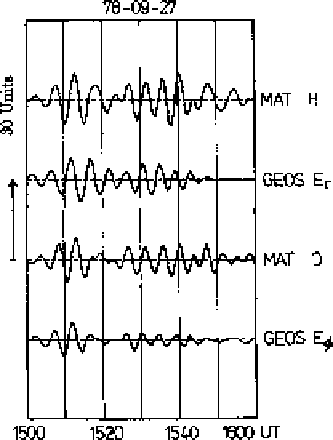Geoscience Reference
In-Depth Information
Fig. 6.7
A Pc5 pulsation event recorded at the ground-based observatory of the Scandinavian
Magnetometer Array in the Finmark (shown with MAT) and in the magnetosphere by the geosta-
tionary satellite GEOS 2 (shown with GEOS). The H and D components of the magnetic variations
have been recorded at the ground-based station while the components of electric variations, E
r
and
E
, were measured on board the satellite. Units of the magnetic and electric variations are nT and
0:1 mV/m, respectively. Taken from Glassmeier (
1995
)
split into five spectral subclasses Pc1 (period 0.2-5 s), Pc2 (5-10 s), Pc3 (10-45 s),
Pc4 (45-150 s), and Pc5 (150-600 s). The period of the Pc oscillations are controlled
by both the parameters of interplanetary space and the resonance properties of the
Earth magnetosphere. The class of irregular pulsations, which have been termed
Pi pulsations (Pulsations irregular), consists of two subclasses Pi1 (1-40 s) and Pi2
(40-150 s). These pulsations are a signature of onset of magnetospheric substorms
which build up as a result of the plasma and solar energy penetration into the
magnetosphere from the interplanetary space during magnetic storms and active
processes on the Sun. Certainly, this classification is fairly relative. There are
complicated and unusual pulsations, in which the regular and irregular oscillations
are mixed.
The typical amplitude of Pc5 pulsations, about 10-50 nT, is the largest among
the ULF pulsation. An example of Pc5 pulsations simultaneously observed at
the ground-based station and in the magnetosphere by the geostationary satellite
GEOS 2 is shown in Fig.
6.7
(Glassmeier
1995
). This event is in favor of the
magnetospheric origin of the Pc5 pulsations. The Pc5 pulsations are latitude-
dependent and are frequently localized within narrow regions extended along
geomagnetic parallels. It is usually the case that the period of the Pc5 pulsation falls
off with decreasing latitude of the sighting point (Ohl
1962
,
1963
; Annexstad and

Search WWH ::

Custom Search